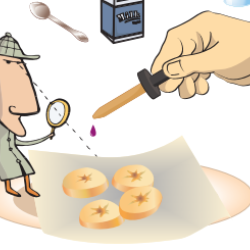Source Institutions
Source Institutions
Add to list Go to activity
Activity link broken? See if it's at the internet archive

In this activity on page 7 of the PDF (Chemistry—It’s Elemental), learners use iodine to identify foods that contain starch. Compare the starch content of a ripe banana, an overripe banana, milk, and flour mixed with water. Use this experiment to introduce learners to starch and how our bodies use starch to break down nutrients during digestion.
Safety notes: DO NOT eat any tested foods or the iodine. Wear goggles. Follow the safety tips on the bottom of page 7 as well as Milli's safety tips on page 5.
Safety notes: DO NOT eat any tested foods or the iodine. Wear goggles. Follow the safety tips on the bottom of page 7 as well as Milli's safety tips on page 5.
- Under 5 minutes
- 10 to 30 minutes
- $1 - $5 per student
- Ages 6 - 14
- Activity, Experiment/Lab Activity
- English, Spanish
Quick Guide
Materials List (per student)
- dropper
- iodine
- 1 tablespoon of flour mixed with 1/3 cup of water
- 1/3 cup of milk, for comparison
- starchy foods to test: banana slices that are overripe (turning brown) and unripe (green)
- 2 plastic cups or containers
- measuring spoons
- 2 paper plates
- paper towels
Subjects
-
Life Sciences
-
Diversity of Life
- Plants
-
Human Body
- Digestion
- Health and Nutrition
-
Diversity of Life
-
Physical Sciences
-
Chemistry
- Chemical Bonding
- Chemical Reactions
- Acids and Bases
- Chemistry of Life
- Solutions
-
Structure and Properties of Matter
- Atomic Structure
-
Chemistry
-
The Nature of Science
-
The Scientific Process
- Conducting Investigations
- Gathering Data
- Formulating Explanations
- Communicating Results
-
The Scientific Process
Informal Categories
- Food and Cooking
- Nature and Environment
Audience
To use this activity, learners need to:
- see
- see color
- read
- touch
Learning styles supported:
- Involves hands-on or lab activities
Other
Foreign language versions of this resource:
Access Rights:
- Free access
By:
- Office of Community Activities, American Chemical Society
Rights:
- All rights reserved, American Chemical Society, 2009
